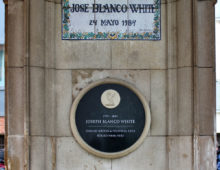Tagged with Drawings
Resource : Cosette Sweeping
Cosette, is a central character in Victor Hugo’s novel, Les Misérables, an epic story with revolution at its very heart. First published in 1862, Hugo’s tale is one of the longest novels in history. It is widely considered to be a masterpiece and has been adapted countless times for stage and screen.
Resource : Theobald Wolfe Tone
Wolfe Tone was a founder of the United Irishmen and a leading figure in the fight for Irish independence from British rule. In 1798, Tone led the United Irishmen in a major uprising, hoping to begin a nationalist and republican revolution in Ireland with the support of French troops.
Resource : William Wilberforce speaking out against slavery in the House of Lords
The movement to abolish the Transatlantic slave trade was a long and difficult struggle. Campaigners for abolition used every means they could, including sugar boycotts, meetings, petitions, publications, and circulating images showing its shameful nature, to bring the issue to people’s attention in Europe. Enslaved Africans played an essential part, having long resisted their enslavement and treatment through ‘go-slows’, revolts, intellectual and religious claims, and demonstrable capacity to retain and transmit their African or creole (mixed) cultures and languages. Escaped or freed slaves forced judges and social elites to confront the issue through court cases, publications, and performances. Propelled by much of this pressure and evidence, William Wilberforce led the long political campaign to outlaw the slave trade in Britain.
Resource : Rebecca and her daughters
In the late 1830s and early 1840s, a series of riots took place in south and mid Wales. Male farmers and labourers – many of them dressed in women’s clothes – rioted in protest against unfair laws and taxes, low wages and toll roads. The rioters called themselves ‘Rebecca’s daughters’ and their actions became known as the Rebecca riots.
Resource : The Plumb-Pudding in Danger
This print was one of over a thousand satires produced by the celebrated caricaturist, James Gillray, who became known as the ‘father of the political cartoon’. In the 18th century, cartoons and caricatures were a popular way of mocking the establishment and calling them to account. They would be discussed and enjoyed in shop windows, coffee houses and taverns. The arrival of the industrial printing press in the 1800s helped to spread them far and wide, through broadsides (posters), newspapers and pamphlets. This one was inspired by the resumed hostilities and ongoing rivalry between Britain and France in 1805.
Resource : The life and adventures of Michael Armstrong, the factory boy by Frances Trollope
This illustrated novel by Frances Trollope (1779-1863) was published in monthly parts in 1840, costing one shilling apiece. It tells a fictional story of Michael Armstrong, based on the real-life hardships, exploitation and suffering of children in the workplaces of the Industrial Revolution. It was the first novel about industrial life in Britain and made an important contribution to the campaign to reform conditions for workers – especially children.
Resource : Frontispiece to Frankenstein or the Modern Prometheus by Mary Shelley
Mary Shelley was one of a number of celebrated female writers of the early 1800s, which included Jane Austen, Charlotte, Emily and Anne Bronte, and Elizabeth Barrett Browning. These writers marked a revolution in the publication and popularity of works by female authors – many of whom initially published their work anonymously or under a male pseudonym. Their writings became a powerful tool for women to make their voices heard outside of the home, take control of their lives and reflect on the position of women in society.


